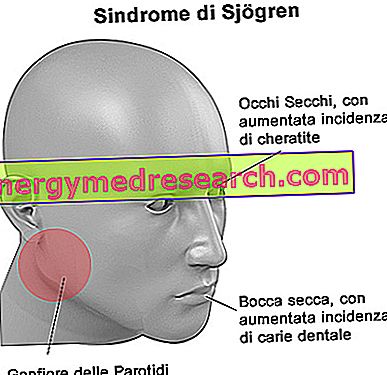Definition
Sjögren's syndrome is a chronic autoimmune inflammatory disease in which various exocrine glands (mainly salivary and lacrimal glands) are destroyed by defense cells, especially T lymphocytes and B lymphocytes.
However, the exocrine glands are not the only target of this syndrome. In fact, the disease can also affect other tissues and organs.
There are basically two types of Sjögren's syndrome: the primitive form that appears on its own without being associated with other pathologies, and the secondary form that occurs in association with other autoimmune diseases such as, for example, rheumatoid arthritis and systemic lupus erythematosus .
Causes
The etiology of Sjögren's syndrome is still unknown, but it is believed that the disease arises in subjects who possess a certain genetic predisposition. Furthermore, it is thought that the autoimmune response can also be triggered by viral infections sustained by certain types of viruses.
However, it seems that the virus can only favor the onset of the disease in genetically predisposed individuals and that the viral infection in itself is not sufficient to trigger the syndrome.
Symptoms
Since it mainly affects and destroys the salivary and lacrimal glands, the main symptoms of Sjögren's syndrome are xerostomia (dry mouth) and xerophthalmia (dry eye). Dry eye - in turn - can lead to the onset of photophobia, dry keratoconjunctivitis, dry eye syndrome and keratitis.
The dryness of the mouth can instead lead to difficulty in swallowing, dysgeusia and ageusia, in addition to favoring the onset of oral candidiasis and caries.
The syndrome, however, can also affect other organs and tissues, causing vaginal dryness, dry skin, nasal dryness, epistaxis, dry cough, bronchitis, dry airways, pleurisy and swelling of the parotids.
Finally, other symptoms that may occur in patients with Sjögren's syndrome are fatigue and joint pain.
Information on Sjögren's Syndrome - Treatment of Sjögren's Syndrome is not intended to replace the direct relationship between health professional and patient. Always consult your doctor and / or specialist before taking Sjögren's Syndrome - Treatment of Sjögren's Syndrome.
drugs
Unfortunately, there are no specific drugs for the treatment of Sjögren's syndrome. The therapies that are prescribed are mostly symptomatic and supportive, and aim to alleviate the symptoms of the disease, so as to improve the quality of life of the patients who are affected.
For this purpose, therefore, drugs are used that can make up for the lack of glandular secretion. Furthermore, anti-inflammatories and immunosuppressants can be used to cause inflammation and reduce the autoimmune reaction that characterizes this syndrome.

Anti-inflammatories
Anti-inflammatory drugs, both steroid (corticosteroids) and non-steroidal drugs (NSAIDs) can be used to treat Sjögren's syndrome.
Furthermore, these drugs are also used in the treatment of diseases that occur in association with the Sjögren syndrome, such as, for example, rheumatoid arthritis and systemic lupus erythematosus (for more detailed information on the drugs used to treat these diseases, see the articles dedicated "Medicines for the treatment of Rheumatoid Arthritis" and "Medicines for treating systemic Lupus erythematosus").
NSAIDs
They are very useful for reducing pain and inflammation caused by Sjögren's syndrome and any associated diseases.
The most widely used non-steroidal anti-inflammatory drugs include:
- Acetylsalicylic acid (Aspirin ®, Ascriptin ®, Alkaeffer ®, Aspirin Pain and Inflammation ®): acetylsalicylic acid is an NSAID with both anti-inflammatory, analgesic and antipyretic activity. The dose of drug usually used ranges from 325 mg to 1000 mg, to be administered orally 2-3 times a day.
- Ibuprofen (Brufen ®, Arfen ®, Nurofen ®, Moment ®): also ibuprofen is an NSAID with anti-inflammatory, analgesic and antipyretic activity. Ibuprofen can be administered orally. The dose of medication to be used must be established by the doctor on an individual basis. However, it is important not to exceed the maximum daily dose of 1, 200 mg of drug.
Corticosteroids
Steroidal anti-inflammatories are exploited for their suppressive action against the immune system, through which they can reduce inflammatory states. They can be used either alone or in combination with immunosuppressive drugs.
Among the corticosteroids most commonly used to alleviate the symptoms of Sjögren's syndrome, we recall:
- Prednisone (Deltacortene ®): the usual dose is 5-15 mg a day. However, the exact dosage of medicine must be established by the doctor on an individual basis, depending on the severity of the disease.
immunosuppressant
Immunosuppressive drugs can be used in the treatment of Sjögren's syndrome to reduce the autoimmune response that characterizes this pathology.
Among the various active ingredients that can be used for this purpose, the most used is:
- Ciclosporina (Ikervis ®, Ciqorin ®, Sandimmun ®): cyclosporine can be used topically (in the form of eye drops) with specific indications for the treatment of dry eye syndrome; or it can be taken orally (in the form of capsules or oral solution). When using ciclosporin based eye drops, it is recommended to instill a drop of product directly into the affected eye just before bedtime. When administered orally, the dose of cyclosporin to be used and the frequency of administration should be established by the doctor.
Other drugs to treat Sjögren's syndrome
Pilocarpine (Salagen ®): pilocarpine is a parasympathomimetic drug that can be used to counteract the ocular and oral dryness caused by Sjögren's syndrome. The dose of medication usually used for the treatment of the aforementioned syndrome is 5 mg, to be taken orally four times a day, during or immediately after meals.
Artificial tears: artificial tears are used to alleviate xerophthalmia caused by Sjögren's syndrome. Among the active ingredients most used, we recall:
- Carmellose sodium (Celluvisc ®): it is generally recommended to instill 1-2 drops of eye drops directly into the conjunctival sac.
- Hyaluronic acid (Dropyal ®, Dropstar ®, Eyestil ®, Hyalistil ®): hyaluronic acid is able to hydrate and lubricate both the cornea and the conjunctiva. The usual dose is 1-2 drops of eye drops, to be administered directly into the eye four or more times a day, or according to a medical prescription.
- Carbomer 974P (Dacriogel ®, Lipogel ®, Siccafluid ®): this active ingredient is available as an ophthalmic gel. The recommended dose is one drop of gel, to be instilled in the conjunctival sac up to four times a day.
Saliva substitutes : used for the treatment of dry mouth, they are generally in the form of a spray.



